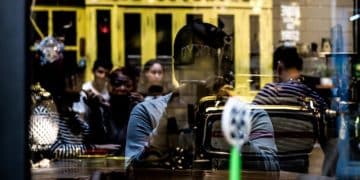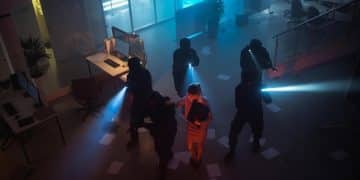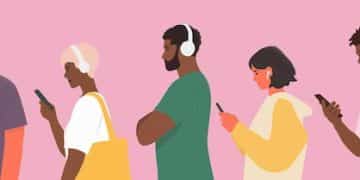Arts Education Boost: Government Funding Benefits US Students
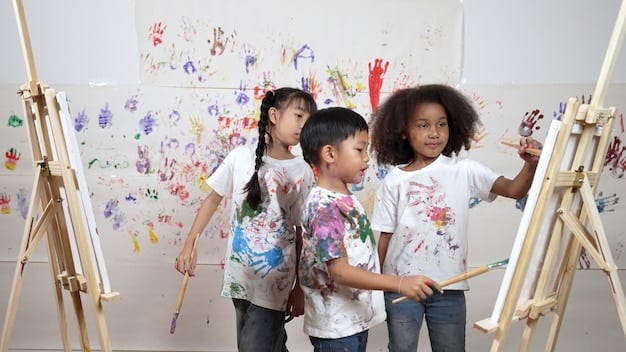
A groundbreaking government initiative is set to inject significant funding into arts education programs across the United States, promising to enhance students’ creativity, critical thinking, and overall academic achievement by expanding access to diverse artistic disciplines and resources in schools nationwide.
The US government has just announced a major funding boost for arts education programs nationwide. This investment promises to reshape the educational landscape, offering students enriched learning experiences and fostering creativity. Let’s delve into how this initiative, Breaking: Government Announces Funding for Arts Education Programs – How Will This Benefit Students Across the US?, will impact students and communities across the country.
The Significance of Arts Education
Arts education plays a crucial role in the holistic development of students. It goes beyond simply learning about art forms; it cultivates essential skills that benefit students academically and personally. Understanding the multifaceted benefits can help appreciate the importance of this government investment.
Enhanced Creativity and Innovation
Arts education nurtures creativity by allowing students to explore new ideas and mediums. This process encourages innovative thinking and problem-solving skills, which are invaluable in today’s rapidly evolving world.
Improved Academic Performance
Studies have shown a correlation between arts education and improved academic performance. Engaging with arts activities can enhance cognitive abilities, boost memory, and improve understanding across different subjects.
- Critical Thinking Skills: Arts require analysis and interpretation, enhancing critical thinking.
- Communication Abilities: Students learn to express ideas effectively through various art forms.
- Emotional Intelligence: Arts provide an outlet for emotional expression and understanding.
- Cultural Awareness: Exposure to diverse art forms fosters an appreciation for different cultures.
In summary, arts education is not just about creating art, but about fostering well-rounded individuals equipped with skills necessary for success in all areas of life. This government funding recognizes the importance of these benefits and seeks to make them accessible to more students.
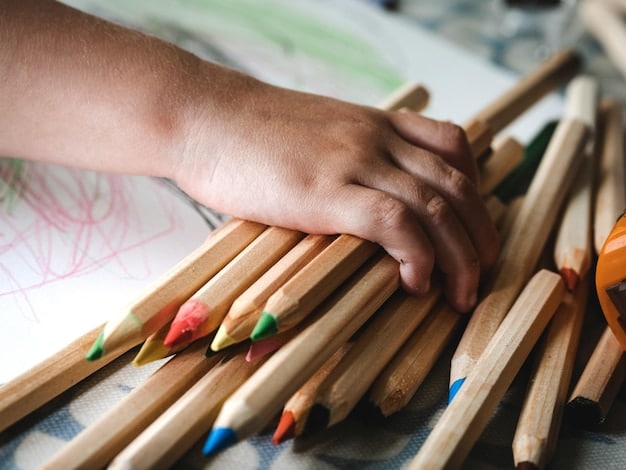
Details of the Government Funding Initiative
The government’s funding initiative for arts education programs represents a significant investment in the future of American students. Understanding the specifics of this initiative, including where the money is allocated and which programs are prioritized, is essential.
Allocation of Funds
The funds will be distributed across various states and school districts based on need and demonstrated commitment to arts education. Priority will be given to programs that reach underserved communities and schools with limited resources.
Key Focus Areas
The initiative will support a range of arts disciplines, including visual arts, music, dance, theater, and media arts. It will also prioritize professional development for arts educators and the integration of arts into other subjects.
- Visual Arts: Painting, sculpture, photography, and graphic design.
- Performing Arts: Music, dance, and theater.
- Media Arts: Filmmaking, animation, and digital media.
- Literary Arts: Creative writing and poetry.
In conclusion, this funding initiative will support a wide range of arts education programs, focusing on accessibility and integration into broader curricula. It represents a comprehensive approach to enhancing arts education across the United States, investing in resources, professional development, and diverse artistic disciplines.
Impact on Students and Schools
The government’s funding for arts education programs is expected to have a far-reaching impact on students and schools alike. By providing students with enriched learning experiences, these programs can transform educational environments and academic outcomes.
Benefits for Students
Students will gain access to a wider range of arts-related opportunities, sparking their creativity and fostering a love for learning. These programs will help them develop valuable skills and prepare them for future success.
Improvements for Schools
Schools will be better equipped to offer high-quality arts education, attracting dedicated teachers and creating a more vibrant learning environment. This investment can help improve overall school performance and community engagement.
- Increased Student Engagement: Arts programs will boost student interest and participation in school.
- Enhanced Teaching Resources: Funds will support the acquisition of necessary equipment and materials.
- Community Partnerships: Schools can collaborate with local artists and organizations to enrich arts programs.
- Positive School Culture: A focus on arts fosters a more inclusive and creative school environment.
In summary, the government’s funding will lead to significant improvements in both student outcomes and school environments. By fostering creativity, enhancing resources, and promoting community engagement, these programs promise to transform education across the United States.
Challenges and Opportunities
While the government funding initiative presents a significant opportunity to enhance arts education, there are also challenges to consider. Recognizing these challenges and exploring potential opportunities is essential for ensuring the success of the initiative.
Addressing Implementation Challenges
Effective implementation of arts education programs requires careful planning and coordination. Schools must be prepared to overcome challenges such as limited resources, teacher training, and curriculum development.
Leveraging Opportunities for Growth
There are opportunities to leverage this funding to create sustainable arts education programs that continue to thrive beyond the initial investment. Collaboration between schools, communities, and arts organizations is essential.
Effective strategies might include:
Creative Solutions
Think outside the box to make sure the funding makes the biggest impact.
- Sustainable Programs: Develop programs that can be sustained long-term through community and school support.
- Teacher Training: Invest in professional development for arts educators to enhance their skills.
- Community Collaboration: Partner with local organizations to enrich arts programs.
In conclusion, while challenges exist, the opportunities presented by this funding initiative are immense. By addressing implementation issues and leveraging collaborative partnerships, the government’s investment can create enduring benefits for students and communities across the United States.

Examples of Successful Arts Education Programs
Examining successful arts education programs can provide valuable insights and inspiration for schools and communities looking to implement similar initiatives. These examples highlight the potential impact of arts education on students’ lives.
The Harlem Children’s Zone
This program provides comprehensive support to children in Harlem, New York, including robust arts education opportunities. The program has shown remarkable success in improving academic outcomes and fostering creativity.
The Los Angeles Music Center
This center offers a range of arts education programs for students in Los Angeles, California. The programs have been instrumental in cultivating a love for music and developing the talents of young musicians.
These programs emphasize:
Holistic Approach
They focus on developing not just artistic skills, but also life skills.
- Community Involvement: Engaging parents and community members in arts programs.
- Interdisciplinary Approach: Integrating arts into other subjects to enhance learning.
- Dedicated Educators: Employing passionate and skilled arts teachers.
In conclusion, these examples demonstrate the transformative power of arts education when implemented effectively. By adopting similar holistic and community-driven approaches, schools and communities across the United States can unlock the full potential of the government’s funding initiative and create lasting benefits for students.
Ensuring Equitable Access to Arts Education
Ensuring equitable access to arts education is a critical aspect of the government’s funding initiative. It is essential to address disparities in access and provide all students with the opportunity to benefit from arts education regardless of their socioeconomic background or geographic location.
Targeting Underserved Communities
Priority should be given to schools in underserved communities that lack the resources to offer high-quality arts education. Targeted funding can help bridge the gap and provide these students with enriched learning experiences.
Breaking Barriers
Many individuals might not have access to the proper training and support.
Creating Inclusive Programs
Creating inclusive arts programs that cater to students with diverse needs and abilities is essential. These programs should be designed to foster inclusivity and accessibility for all students.
This might include:
- Adaptive Programs: Creating specially tailored programs for students with disabilities.
- Culturally Relevant Curriculum: Diversifying the curriculum to reflect the cultural backgrounds of all students.
- Financial Support: Providing scholarships and financial aid to ensure that all students can participate.
In conclusion, ensuring equitable access to arts education requires a deliberate effort to target underserved communities and create inclusive programs. By prioritizing equity and accessibility, the government’s funding initiative can help level the playing field and provide all students with the opportunity to explore their creative potential.
| Key Point | Brief Description |
|---|---|
| 🎨 Funding Boost | Government allocates funds for arts education. |
| 📚 Improved Academics | Arts education linked to better academic performance. |
| 🌟 Community Impact | Schools and communities benefit from enriched arts programs. |
| 🤝 Partnerships | Collaboration enhances program sustainability and impact. |
Frequently Asked Questions
▼
The main objective is to boost arts education across the US, providing more students access to artistic disciplines, fostering creativity, and enhancing academic abilities through improved resources.
▼
Students in underserved communities and schools with limited resources are expected to benefit most, as the initiative prioritizes programs that bridge educational gaps for these students.
▼
The initiative supports diverse art forms, including visual arts, music, dance, theater, and media arts, aiming for a balanced distribution to promote a wide array of artistic experiences.
▼
The initiative emphasizes professional development for arts educators, ensuring they have the necessary skills and resources to effectively integrate arts into the curriculum and inspire their students.
▼
Communities can collaborate with schools and local arts organizations, offering resources, mentorship, and support to enrich arts education programs, creating a stronger connection between education and the community.
Conclusion
The government’s funding initiative for arts education programs marks a pivotal moment for students across the United States. By investing in creativity, innovation, and equitable access, this initiative promises to unlock the full potential of American students and transform the educational landscape for generations to come.

